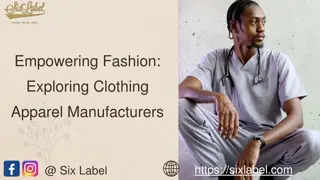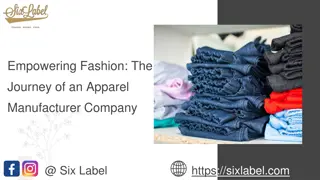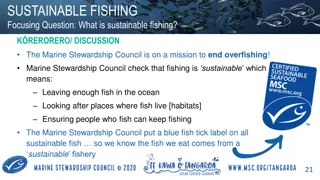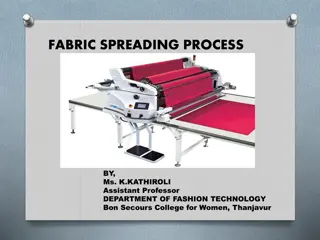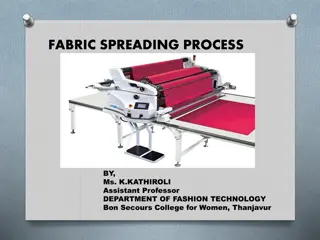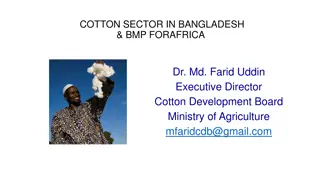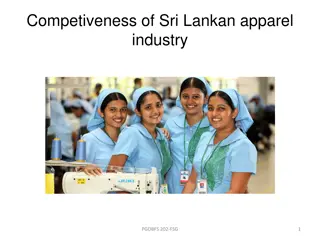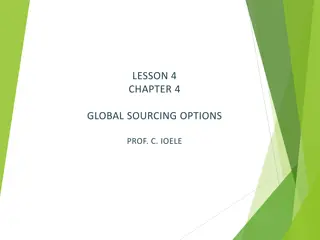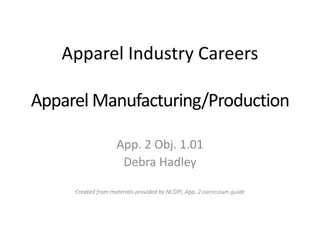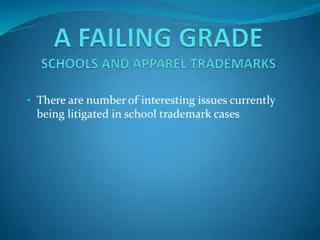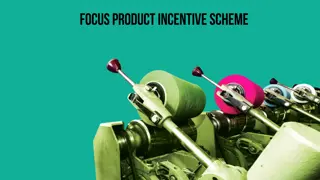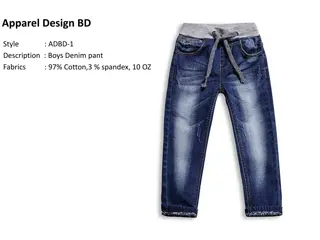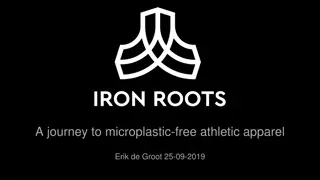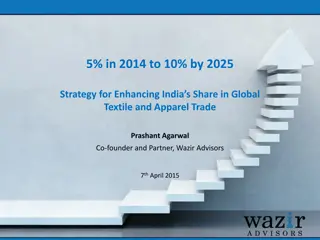Sustainable Practices in the Apparel Industry
Discover how the apparel industry is making changes to reduce environmental impacts through transparency, innovation in fiber production, and initiatives targeting significant phases of product lifecycle. Learn about efforts to reduce carbon emissions, energy use, and water consumption in the production and consumer use phases. Brands like Patagonia and Levi's are leading the way in sustainability practices.
Download Presentation

Please find below an Image/Link to download the presentation.
The content on the website is provided AS IS for your information and personal use only. It may not be sold, licensed, or shared on other websites without obtaining consent from the author. Download presentation by click this link. If you encounter any issues during the download, it is possible that the publisher has removed the file from their server.
E N D
Presentation Transcript
Educator Instructions REMOVE THIS SLIDE BEFORE PRESENTING Customize this presentation to fit your needs. Please add or remove content.
AT INDUSTRY AND SUSTAINABILITY
CHANGES THE AT INDUSTRY IS MAKING TO REDUCE ENVIRONMENTAL IMPACTS o Learn more about the sources of the materials used in their products o Share what they have learned with consumers, an effort towards transparency o Creates a competitive advantage that outweighed the benefits of keeping their sources secret
CERTAIN PHASES OF A PRODUCTS LIFE CYCLE HAVE SIGNIFICANT ENVIRONMENTAL IMPACTS Conducting a life-cycle analysis of their products revealed that there were certain phases where products and processes had significant environmental impacts (Smith & Barker, 1995). The initial focus was often on the fibers used for products, and companies like Patagonia led the transparency movement by switching to organic cotton and then sharing with their customers the rationale behind the change (Chouinard & Brown, 1997).
REDUCE THE ENVIRONMENTAL IMPACT OF FIBER PRODUCTION At the same time, researchers were working to develop fiber from materials, such as PLA (Polylactic Acid), that could reduce the environmental impact of fiber production while keeping the properties, such as easy care, that consumers had come to value (Vink et al., 2003).
THE CONSUMER USE PHASE OF APPAREL PRODUCTS HAS THE MOST SIGNIFICANT IMPACT ON CARBON EMISSIONS THROUGH ENERGY USE When lifecycle analyses showed that the consumer use phase of apparel products have the most significant impact on carbon emissions through energy use (Allwood et al., 2015), the AT industry also began working on changing care labels to encourage energy reduction.
WATER, LIKE ENERGY, IS VITAL TO THE AT INDUSTRY Besides the concern about energy use and its relationship to climate change through carbon emissions, the AT industry depends on water for almost every phase of production, from water for crops to water for laundry (Morrison et al., 2009). Brands like Levi s have developed innovations in textile processing that reduce water consumption and created educational campaigns to help their customers reduce water use at home (http://store.levi.com/waterless/). DyeCoo, a process of waterless dyeing with reclaimed CO2 uses a closed loop system that produces no waste water and is energy efficient is being used to dye textiles (http://www.dyecoo.com/co2- dyeing/).
GROUPS SUCH AS THE SUSTAINABLE APPAREL COALITION HAVE FORMED Groups such as the Sustainable Apparel Coalition have formed to share tools created by leaders in the AT industry to improve the ability of designers, producers and retailers to reduce the impact of their products on climate change (http://apparelcoalition.org/the-higg-index/).
Activity: Waste Equals Food Jeopardy (View PowerPoint) IN-CLASS ACTIVITY Activity: Assign Chapter 4 Waste Equals Food from Cradle to Cradle: Remaking the Way We Make Things McDonough, W. & Braungart, M. (2002). Cradle to Cradle: Rethinking the Way We Make Things. New York: North Point Press. View video listed in More Information and Resources: WeWantToLearn.Net Waste = Food (Cradle to Cradle) (49:19 minutes) Activity: Waste Equals Food Lecture Slides (View PowerPoint)
WeWantToLearn.Net Waste = Food (Cradle to Cradle) (49:19 minutes) https://wewanttolearn.wordpress.com/2012/04/16/wast e-food-cradle-to-cradle/ MORE INFORMATION AND RESOURCES On this page A Business Leading on Sustainability about Interface Carpet (5:17 minutes) http://sustainabilityhub.com/newvideos/ V&A joint fashion and climate change hackathon https://www.youtube.com/watch?v=5A_sKZvoV0o TED Talk Changing the World Through Fashion: Eva Kruse https://www.youtube.com/watch?v=d4VTPLpfGq0 Nicole Bridger: Sustainable Fashion https://www.youtube.com/watch?v=mak8FqhnPKM
Allwood, J.M., Laursen, S.E., de Rodrguez, C.M., & Bocken, N.M.P. (2015). Well dressed?: The present and future sustainability of clothing and textiles in the United Kingdom, 42. Available: http://www.ifm.eng.cam.ac.uk/resources/sustainability/well- dressed/ REFERENCES Bell, D.E., Nitin S., & Winig, L. Marks and Spencer: Plan A. Harvard Business School Case 509-029, January 2009. Available: http://www.econ1.fudan.edu.cn/userfiles/file/2012040107045 7562.PDF Chouinard, Y. & Brown. M.S. (1997). Going organic: converting Patagonia's cotton product line. Journal of Industrial Ecology 1(1), 117-129. Morrison, J., Morikawa, M., Murphy, M., & Schulte, P. (2009). Water scarcity & climate change: Growing risks for businesses and investors. Oakland, CA: Pacific Institute. Available: http://www.ceres.org/resources/reports/water-scarcity- climate-change-risks-for-investors-2009
Nimon, W. & Beghin J. (1999). Are eco-labels valuable? Evidence from the apparel industry. American Journal of Agricultural Economics 81(4), 801-811. Porter, M.E. & Kramer, M.R. (2006). The link between competitive advantage and corporate social responsibility. Harvard business review 84(12), 78-92. REFERENCES (continued) Smith, G. G. & Barker, R.H. (1995). Life cycle analysis of a polyester garment.Resources, conservation and recycling 14(3), 233-249. Vink, E.T.H., R bago, K.R., Glassner, D.A., & Gruber, P.R. (2003). Applications of life cycle assessment to NatureWorks polylactide (PLA) production. Polymer degradation and stability 80(3), 403-419. Available: http://www.natureworksllc.com/~/media/The_Ingeo_Journey/ EcoProfile_LCA/EcoProfile/NTR_CompleteLCA_EcoProfile_1102 _pdf.pdf?la=en




